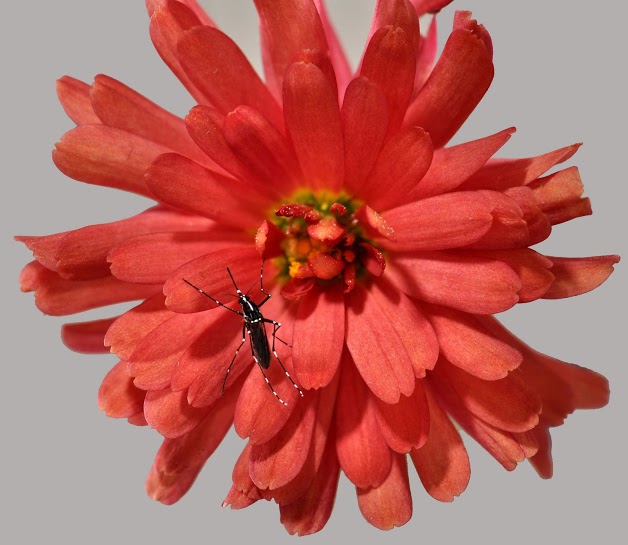
Home gardeners without a travel history will be the “canaries in the coal mine” for emerging Zika virus, the harbingers of transmission. Although Zika virus infection in healthy humans is usually mild (http://www.cdc.gov/zika/symptoms), this virus can have dangerous and life-long effects in newborns of infected mothers (http://www.cdc.gov/zika/pregnancy/index.html). It is therefore especially important to understand the risks and best strategies for prevention and control.
Zika virus infections primarily result from a bite by an infected female mosquito looking for a bloodmeal, and mosquitoes only become infected by biting an infected person. Infected travelers from Central and South America will be the mode of entry of the virus to North America and already almost 600 travel-associated cases have been reported. However, as of this writing in early June 2016, there is yet no ongoing transmission of Zika virus in the US. As the “mosquito season” starts, the questions in everyone’s mind are: will local transmission occur and how many people will become infected?
Due to their exposure risk, gardeners may become the first victims and the weak link enhancing Zika virus transmission. However, informed gardeners can take steps to significantly reduce the risk to themselves and their communities.
Mosquitoes, like garden plants, can be “native” or “exotic”. Like native plants, native mosquitoes are often skittish, hard to grow, and rare in cities and suburbs. In contrast, like exceptional exotic plants developed through careful breeding, exotic mosquitoes have been unwittingly “bred” to thrive in polluted nutrient rich cities and suburbs with no predators, which allow them to become very abundant. Our close association has also selected for mosquitoes that bite humans.
There are currently two mosquito species known to transmit Zika virus, both day-biters and both can occur in NJ. Aedes aegypti, a tropical species originally from Africa was first identified as the vector of yellow fever virus (and therefore called the “yellow fever mosquito”) and Aedes albopictus, the “Asian tiger mosquito”, originally from Japan. Like Purple loosestrife, Japanese honeysuckle and the common daylily, these exotic mosquitoes also spread aggressively, often aided by gardeners. Aedes albopictus has a year-round presence in NJ surviving the winter as cold-hardy eggs. Tropical Aedes aegypti occurs in NJ only during the summer after chance introductions from southern states.
Aedes females lay eggs in small containers with water. Eggs are deposited above the water line and develop after a rain event or a sprinkler floods them. Mosquito immature, which are called larvae or wrigglers, are aquatic. The most common mosquito infested containers in NJ are used tires, buckets, toys, birdbaths, plant saucers and corrugated gutter extensions in private yards and gardens. While well developed, NJ professional county mosquito control programs have very limited jurisdiction in private areas and are unable to develop cost-effective approaches to control these domestic mosquitoes.
The incontrovertible conclusion is that those that spend time outdoors during the day are most at risk to become infected with Zika virus, and if infected will serve as sources of infection to local Aedes mosquitoes, fuelling local transmission. While any outdoor-activity such as construction or deliveries, increases the risk of a mosquito bite, dusty, hot and especially dry environments (construction) and continuous motion (deliveries), deter mosquitoes. In contrast, home gardeners or those tending urban farms surrounded by cool moist environments and crouching close to the ground are easy prey for low flying biting Aedes females. Gardeners must be aware of the risk and act on it.
The first line of defense is personal protection. Use effective repellents and reapply them according to label and CDC guidelines (http://www.cdc.gov/zika/prevention). Wear long sleeves and long pants and treat your clothing with recommended insecticides such as permethrin or other Environmental Protection Agency (EPA)-registered insecticide.
To reduce local mosquito populations empty or remove unnecessary water-holding containers in your property. However, if feasible, maintain one or two containers with water treated with a long lasting larvicide such as Bacillus thuringiensis israelensis (BTI), a naturally occurring bacterium (https://www.cdc.gov/chikungunya/pdfs/surveillance-and-control-of-aedes-aegypti-and-aedes-albopictus-us.pdf). Formulations of BTI are labeled for organic gardeningand are harmless to people, pets, wildlife or fish. Although this “decoy” approach is still broadly experimental it acts to prevent females looking for a place to lay eggs from just moving on. Instead, they will lay eggs in the treated water where the larvae will perish.
However, this will only work if the BTI is kept active, otherwise the trap will instead become a source of dangerous mosquitoes. A BTI dunk in water degrades slowly releasing the bacterium and will last for at least a month. Talk to your neighbors, organize and spread information on mosquito control and prevention. Make sure that is the only similarity between you and a canary.
This month’s column is written by Dr. Dina Fonseca, Professor of Entomology, Ecology&Evolution and Public Health.
